2017 RENAULT TALISMAN navigation system
[x] Cancel search: navigation systemPage 28 of 130
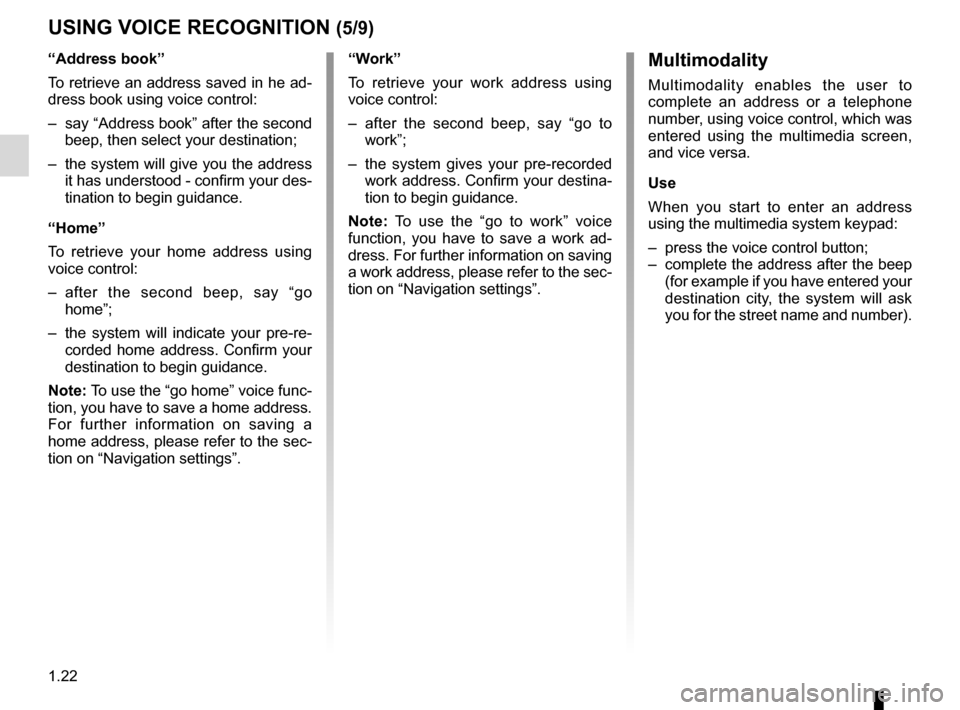
1.22
USING VOICE RECOGNITION (5/9)
“Address book”
To retrieve an address saved in he ad-
dress book using voice control:
– say “Address book” after the second beep, then select your destination;
– the system will give you the address it has understood - confirm your des-
tination to begin guidance.
“Home”
To retrieve your home address using
voice control:
– after the second beep, say “go home”;
– the system will indicate your pre-re- corded home address. Confirm your
destination to begin guidance.
Note: To use the “go home” voice func-
tion, you have to save a home address.
For further information on saving a
home address, please refer to the sec-
tion on “Navigation settings”.Multimodality
Multimodality enables the user to
complete an address or a telephone
number, using voice control, which was
entered using the multimedia screen,
and vice versa.
Use
When you start to enter an address
using the multimedia system keypad:
– press the voice control button;
– complete the address after the beep (for example if you have entered your
destination city, the system will ask
you for the street name and number).
“Work”
To retrieve your work address using
voice control:
– after the second beep, say “go to
work”;
– the system gives your pre-recorded work address. Confirm your destina-
tion to begin guidance.
Note: To use the “go to work” voice
function, you have to save a work ad-
dress. For further information on saving
a work address, please refer to the sec-
tion on “Navigation settings”.
Page 30 of 130
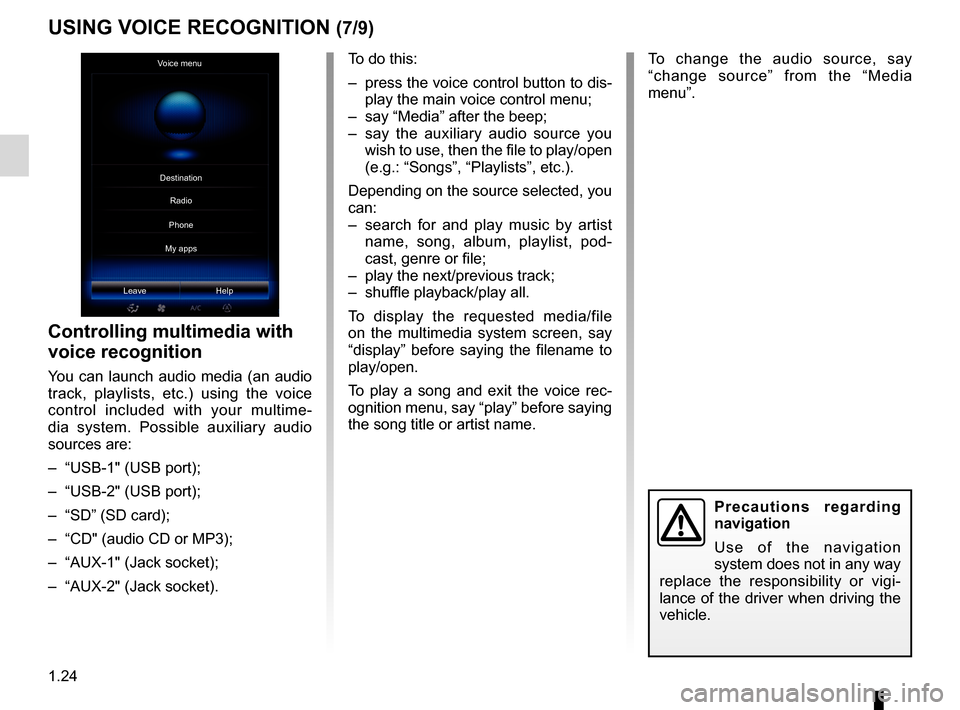
1.24
To change the audio source, say
“change source” from the “Media
menu”.
USING VOICE RECOGNITION (7/9)
Voice menu
Leave Help
Controlling multimedia with
voice recognition
You can launch audio media (an audio
track, playlists, etc.) using the voice
control included with your multime-
dia system. Possible auxiliary audio
sources are:
– “USB-1" (USB port);
– “USB-2" (USB port);
– “SD” (SD card);
– “CD" (audio CD or MP3);
– “AUX-1" (Jack socket);
– “AUX-2" (Jack socket). To do this:
– press the voice control button to dis-
play the main voice control menu;
– say “Media” after the beep;
– say the auxiliary audio source you wish to use, then the file to play/open
(e.g.: “Songs”, “Playlists”, etc.).
Depending on the source selected, you
can:
– search for and play music by artist name, song, album, playlist, pod-
cast, genre or file;
– play the next/previous track;
– shuffle playback/play all.
To display the requested media/file
on the multimedia system screen, say
“display” before saying the filename to
play/open.
To play a song and exit the voice rec-
ognition menu, say “play” before saying
the song title or artist name.
Precautions regarding
navigation
Use of the navigation
system does not in any way
replace the responsibility or vigi-
lance of the driver when driving the
vehicle.
Destination
Phone
My apps Radio
Page 32 of 130

1.26
USING VOICE RECOGNITION (9/9)
“Help”
To find out more about using voice
functions:
– press the voice control button, then say “Help”.
The system displays a number of help
categories on the screen.
– Select the required function.
The “Help” function is available at all
times. For example, if you wish to find
the “Phone” on the screen and you say
“Help”, the help voice will assist you in
using the function.
Launch an application using
voice recognition
You can launch an app using the voice
control included with your multimedia
system. To do this:
– press the voice control button to dis- play the main voice control menu;
– say “My apps” after the beep;
– state the name or number (displayed in front of the app name) of the app
you wish to run to start using it imme-
diately.
Precautions regarding
navigation
Use of the navigation
system does not in any way
replace the responsibility or vigi-
lance of the driver when driving the
vehicle.
Page 34 of 130
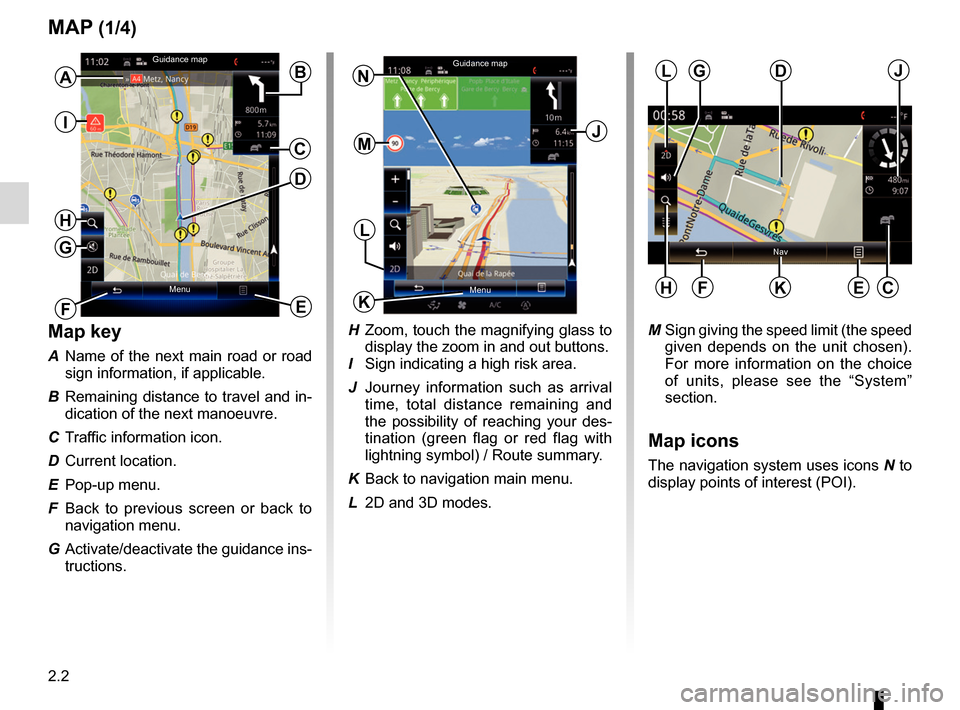
2.2
MAP (1/4)
Map key
A Name of the next main road or road sign information, if applicable.
B Remaining distance to travel and in- dication of the next manoeuvre.
C Traffic information icon.
D Current location.
E Pop-up menu.
F Back to previous screen or back to navigation menu.
G Activate/deactivate the guidance ins- tructions.
E
B
M Sign giving the speed limit (the speed given depends on the unit chosen).
For more information on the choice
of units, please see the “System”
section.
Map icons
The navigation system uses icons N to
display points of interest (POI).
D
H Zoom, touch the magnifying glass to display the zoom in and out buttons.
I Sign indicating a high risk area.
J Journey information such as arrival time, total distance remaining and
the possibility of reaching your des-
tination (green flag or red flag with
lightning symbol) / Route summary.
K Back to navigation main menu.
L 2D and 3D modes.
J
L
Menu MenuK
N
H
Nav
L
KEF
DJ
C
Guidance map
Guidance map
F
MC
G
H
I
GA
Page 35 of 130
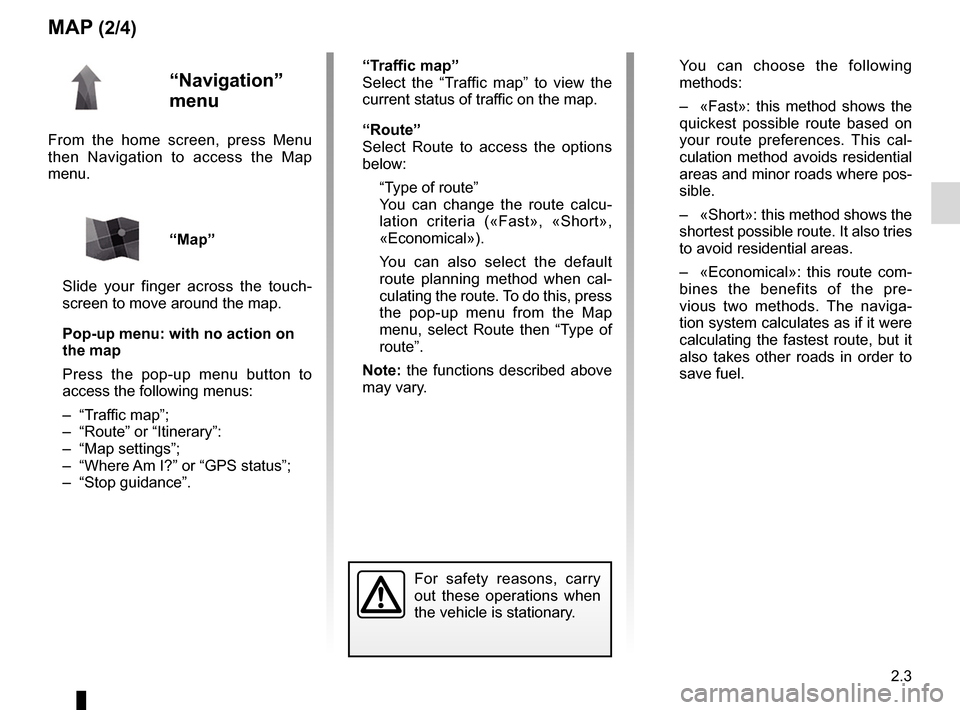
2.3
MAP (2/4)
“Navigation”
menu
From the home screen, press Menu
then Navigation to access the Map
menu.
“Map”
Slide your finger across the touch-
screen to move around the map.
Pop-up menu: with no action on
the map
Press the pop-up menu button to
access the following menus:
– “Traffic map”;
– “Route” or “Itinerary”:
– “Map settings”;
– “Where Am I?” or “GPS status”;
– “Stop guidance”.
“Traffic map”
Select the “Traffic map” to view the
current status of traffic on the map.
“Route”
Select Route to access the options
below:
“Type of route”
You can change the route calcu- lation criteria («Fast», «Short»,
«Economical»).
You can also select the default route planning method when cal-
culating the route. To do this, press
the pop-up menu from the Map
menu, select Route then “Type of
route”.
Note: the functions described above
may vary. You can choose the following
methods:
– «Fast»: this method shows the quickest possible route based on
your route preferences. This cal-
culation method avoids residential
areas and minor roads where pos-
sible.
– «Short»: this method shows the shortest possible route. It also tries
to avoid residential areas.
– «Economical»: this route com- bines the benefits of the pre-
vious two methods. The naviga-
tion system calculates as if it were
calculating the fastest route, but it
also takes other roads in order to
save fuel.
For safety reasons, carry
out these operations when
the vehicle is stationary.
Page 36 of 130
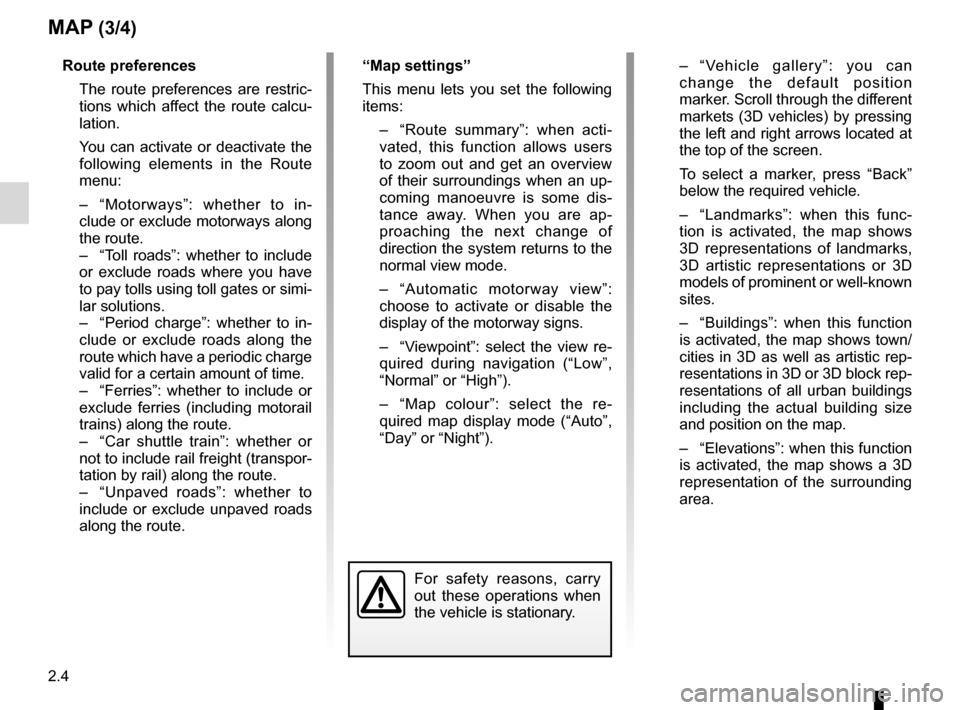
2.4
– “Vehicle gallery”: you can change the default position
marker. Scroll through the different
markets (3D vehicles) by pressing
the left and right arrows located at
the top of the screen.
To select a marker, press “Back” below the required vehicle.
– “Landmarks”: when this func- tion is activated, the map shows
3D representations of landmarks,
3D artistic representations or 3D
models of prominent or well-known
sites.
– “Buildings”: when this function is activated, the map shows town/
cities in 3D as well as artistic rep-
resentations in 3D or 3D block rep-
resentations of all urban buildings
including the actual building size
and position on the map.
– “Elevations”: when this function is activated, the map shows a 3D
representation of the surrounding
area.
MAP (3/4)
For safety reasons, carry
out these operations when
the vehicle is stationary.
Route preferences
The route preferences are restric-tions which affect the route calcu-
lation.
You can activate or deactivate the following elements in the Route
menu:
– “Motorways”: whether to in- clude or exclude motorways along
the route.
– “Toll roads”: whether to include or exclude roads where you have
to pay tolls using toll gates or simi-
lar solutions.
– “Period charge”: whether to in- clude or exclude roads along the
route which have a periodic charge
valid for a certain amount of time.
– “Ferries”: whether to include or exclude ferries (including motorail
trains) along the route.
– “Car shuttle train”: whether or not to include rail freight (transpor-
tation by rail) along the route.
– “Unpaved roads”: whether to include or exclude unpaved roads
along the route. “Map settings”
This menu lets you set the following
items:
– “Route summary”: when acti-
vated, this function allows users
to zoom out and get an overview
of their surroundings when an up-
coming manoeuvre is some dis-
tance away. When you are ap-
proaching the next change of
direction the system returns to the
normal view mode.
– “Automatic motorway view”: choose to activate or disable the
display of the motorway signs.
– “Viewpoint”: select the view re- quired during navigation (“Low”,
“Normal” or “High”).
– “Map colour”: select the re- quired map display mode (“Auto”,
“Day” or “Night”).
Page 38 of 130
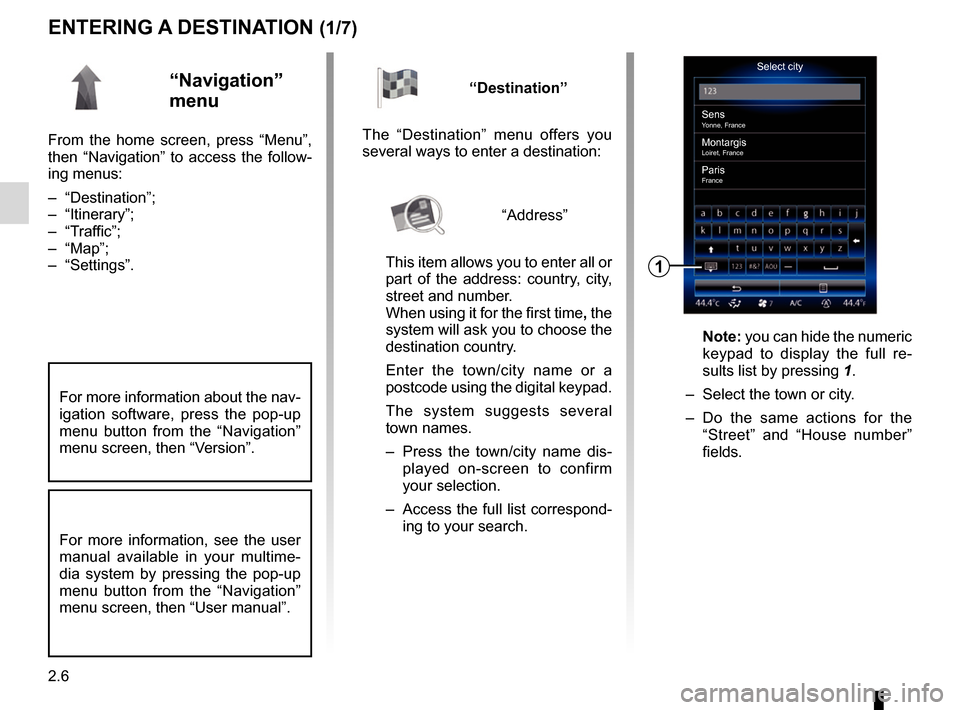
2.6
ENTERING A DESTINATION (1/7)
“Navigation”
menu
From the home screen, press “Menu”,
then “Navigation” to access the follow-
ing menus:
– “Destination”;
– “Itinerary”;
– “Traffic”;
– “Map”;
– “Settings”.
Select city
Sens
Yonne, France
MontargisLoiret, France
ParisFrance
1
“Destination”
The “Destination” menu offers you
several ways to enter a destination:
“Address”
This item allows you to enter all or
part of the address: country, city,
street and number.
When using it for the first time, the
system will ask you to choose the
destination country.
Enter the town/city name or a
postcode using the digital keypad.
The system suggests several
town names.
– Press the town/city name dis- played on-screen to confirm
your selection.
– Access the full list correspond- ing to your search.
Note: you can hide the numeric
keypad to display the full re-
sults list by pressing 1.
– Select the town or city.
– Do the same actions for the “Street” and “House number”
fields.
For more information, see the user
manual available in your multime-
dia system by pressing the pop-up
menu button from the “Navigation”
menu screen, then “User manual”.
For more information about the nav-
igation software, press the pop-up
menu button from the “Navigation”
menu screen, then “Version”.
Page 39 of 130
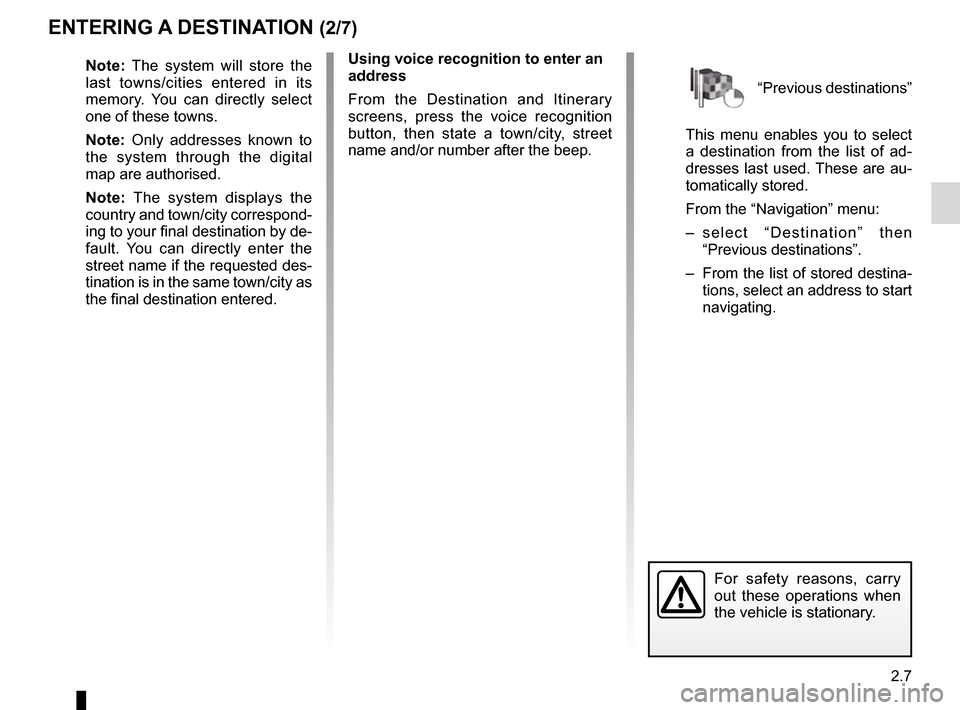
2.7
“Previous destinations”
This menu enables you to select
a destination from the list of ad-
dresses last used. These are au-
tomatically stored.
From the “Navigation” menu:
– select “Destination” then “Previous destinations”.
– From the list of stored destina- tions, select an address to start
navigating.
ENTERING A DESTINATION (2/7)
For safety reasons, carry
out these operations when
the vehicle is stationary.
Note: The system will store the
last towns/cities entered in its
memory. You can directly select
one of these towns.
Note: Only addresses known to
the system through the digital
map are authorised.
Note: The system displays the
country and town/city correspond-
ing to your final destination by de-
fault. You can directly enter the
street name if the requested des-
tination is in the same town/city as
the final destination entered. Using voice recognition to enter an
address
From the Destination and Itinerary
screens, press the voice recognition
button, then state a town/city, street
name and/or number after the beep.